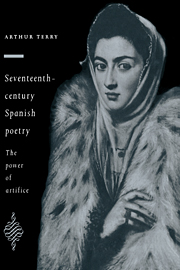Book contents
- Frontmatter
- Contents
- Preface
- List of abbreviations
- 1 The inheritance
- 2 Theory and practice
- 3 Luis de Góngora: the poetry of transformation
- 4 Lope de Vega: re-writing a life
- 5 Between two centuries: from Medrano to Valdivielso
- 6 Francisco de Quevedo: the force of eloquence
- 7 The literary epic
- 8 Plenitude and decline: from Villamediana to the second half of the century
- 9 Sor Juana Inés de la Cruz: the end of a tradition
- Epilogue
- Notes
- Select bibliography
- Index
6 - Francisco de Quevedo: the force of eloquence
Published online by Cambridge University Press: 01 October 2009
- Frontmatter
- Contents
- Preface
- List of abbreviations
- 1 The inheritance
- 2 Theory and practice
- 3 Luis de Góngora: the poetry of transformation
- 4 Lope de Vega: re-writing a life
- 5 Between two centuries: from Medrano to Valdivielso
- 6 Francisco de Quevedo: the force of eloquence
- 7 The literary epic
- 8 Plenitude and decline: from Villamediana to the second half of the century
- 9 Sor Juana Inés de la Cruz: the end of a tradition
- Epilogue
- Notes
- Select bibliography
- Index
Summary
The Flores of Espinosa (1605) includes eighteen poems by Francisco de Quevedo (1580–1645) – a high proportion for a poet at the beginning of his career, and a sure indication of Espinosa's taste for the new. Like Lope de Vega (and unlike Góngora), Quevedo was also a prolific writer in other genres: his two most famous prose works, the Vida del Buscón (Life of the Swindler; 1626) and the satirical fantasies of the Sueños (Visions; 1627) – both begun when he was still in his twenties – are among the masterpieces of the period, and the many volumes of didactic writings, on subjects ranging from statecraft to Stoic philosophy, are remarkable both for their erudition and for the unremitting seriousness of their moral arguments. Given the sheer size and variety of such an oeuvre, generalization seems especially hazardous; yet, as Claudio Guillén points out, there is a real sense in which Quevedo's work as a whole constitutes a body of ‘writing’ – an écriture – which deliberately cuts across conventional notions of genre as a means of liberating the powers of language itself.
Where the poetry is concerned, this involves both Quevedo's attitude to his models and his trust in the strengths of traditional rhetoric. Such matters, moreover, are not solely literary: insofar as they affect the composition of particular poems, they also raise the whole question of the ‘self’ which is being projected through the medium of language, and of the reader's response, both emotional and intellectual, to the words he is made to re-enact. And as we shall see, to realize the full implications of this is to by-pass the kind of circular argument which draws autobiographical inferences from the poetry only to project them back on it in different forms.
- Type
- Chapter
- Information
- Seventeenth-Century Spanish Poetry , pp. 152 - 179Publisher: Cambridge University PressPrint publication year: 1993



